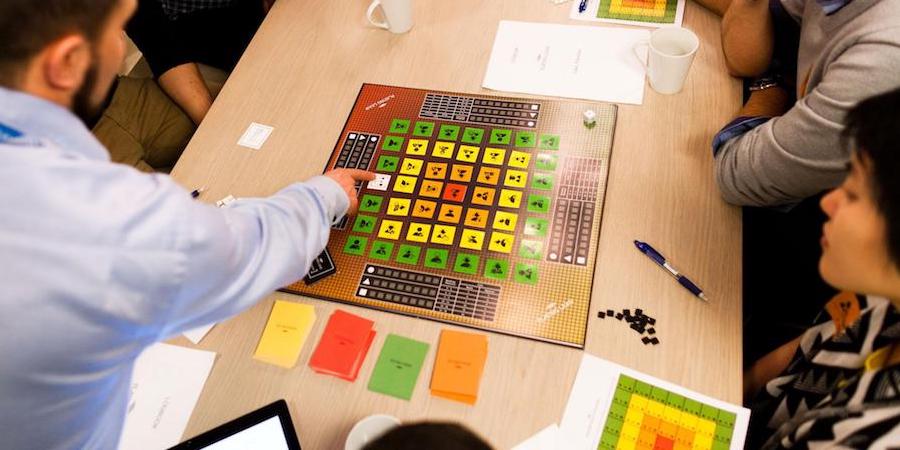
Games as a way to coach and teach lean thinking
FEATURE – Simulations and games can be extremely beneficial, so long as we use them to highlight and explain the underlying behaviors we must adopt if we are to successfully embrace lean... and not only the tools.
Words: Bruno Pešec, industrial engineer, lean practitioner and martial artist
From a theoretical standpoint, most lean principles and tools are relatively easy to understand. The challenge seems to appear with their practical application – which is why the only place to learn lean is the workplace, the very environment in which the work is done.
Short lectures or workshops before moving to the gemba are common, and can greatly enhance the learning. Because this sort of classroom training tends to be perceived as boring, however, one could be excused for seeing it as a one-sided form of education (the teacher explains different concepts and the audience is either writing notes or battling sleep).
Indeed, as lean coaches, we must always look for new ways to improve the learning experience, and I have personally found that using games and simulations works quite well.
TEACHING GAMIFIED
Teaching lean thinking this way is a commonly recognized approach in our community. There are numerous lean games out there – free or requiring payment, physical or online. (Martin Boersema provides a 50-strong list of lean games and simulations here.) There is even an academic term for meshing education with gameplay: “gamification”, which Huotari and Hamari (2012) define as a process of enhancing a service with affordances for gameful experiences in order to support user’s overall value creation. Ramos, Lopes and Avila (2013) say that using games as teaching tools benefits the teaching-learning process, especially when it comes to:
- introducing difficult concepts;
- developing problem-solving and decision-making skills;
- promoting an active participation of the student;
- increased interest among students;
- developing each student’s talents, which welcomes students at different learning levels; and
- helping the teacher identify each student’s difficulties.
What I also found is that they are a great way to kick-start one’s journey to understanding and accepting new principles. In Teaching Lean Manufacturing With Simulations and Games (2010), the authors explore different lean games and simulations, and how they help develop various lean skills, behaviours and traits. More importantly, they discuss the importance of the role of the facilitator: in other words, these games and simulations are most effective when run by a facilitator who is knowledgeable and experienced about lean thinking and practice and possesses good communication and storytelling skills.
UNDERSTANDING LEAN STARTUP WITH A GAME
Lean Startup is a methodology for developing businesses and products, aiming to shorten product development cycles by adopting a combination of hypothesis-driven experimentation, iterative product releases, and validated learning. It seeks to eliminate wasteful practices and increase value-creating practices during the product development phase by focusing on what customers truly want.
Simen Fure Jørgensen, the former CEO of a Norwegian software development consultancy, has been using the getKanban board game to teach people kanban in knowledge environments, with great success. When he started teaching Lean Startup, he quickly began to look for a game that would help him. Struggling to find one, he decided to create one. He called it Playing Lean.
What I like about Playing Lean is that the game, too, was developed using Lean Startup principles. After validating the problem, Jørgensen was joined by Tore Rasmussen, an entrepreneur who was at that time looking for a research project for his master’s thesis. Together, they ran a lot of experiments, taking the game through numerous iterations before they had the product they knew customers truly wanted.
To date, I’ve used Playing Lean in more than 30 workshops, with over 500 people playing it. I found the game really helps convey fundamental lean principles, and it really works as a team-building tool.
Game mechanics are simple, fun and fast to grasp (one turn, approximately 10 minutes). Players are divided into teams and assume the role of a fictional startup. Teams then compete in the same market and for the same customers, with the goal of being the first to reach scale (e.g. more than 100,000 customers in the Social Media scenario).
The game is divided in two phases: planning and execution. In the planning phase teams assign their employees one of the following tasks: develop a product, train, run an experiment or sell. Discussions are normally lively during this phase – how do we proceed? What strategy do we want to pursue? Do we want to satisfy all the customers or look for the quickest path to “victory”? How do we handle competition? Do we want to make the best product or do we want to invest time to find out what the customers want? These questions, and the discussions they generate, are very valuable for the learning experience of the attendees (once again, the role of the facilitator is crucial). In the execution phase, teams will find out what the outcome of their actions is. In case of product development and staff training, there are no uncertainties. When it comes to experimentation, there is an element of randomness as the experiment might fail or succeed, with varying results. A failed sale has long lasting consequence, namely that customer will not give another go at the failing team’s product.
The only way for teams to advance in the game is by selling their product successfully. Following the four stages of Lean Startup, all teams begin at the Business Modelling stage, working their way through Problem/Solution fit and Product/Market fit stages, before finally reaching Scaling stage. There is only one winner – the team that reaches scaling stage first.
The game is designed to engage and entertain participants, opening them up to new thinking paradigms. Due to the short attention span our world is characterized by, learning and playing must be carefully balanced. When I play this game, my way of achieving this – and ensuring people learn – is using Experiment Cards and Retrospection sessions.
Each experiment card introduces one of the Lean Startup principles, tools or methods. It has a title, a short description and a “result” (how much you, as a participant in the game, have learned about the customer). To maximize learning, the facilitator might want to tell a story related to the card, sharing his experience and explaining real-life examples of how the tool or method can be applied.
In my experience, another fundamental moment of learning occurs when the game is over, by means of a retrospection session (either guided or not). Giving the teams the time to reflect on why their team won or lost, on their overall strategy, on their fictional company’s need to pivot and on whether they were affected by technical debt typically leads to several a-ha moments. And because of the emotional involvement that games facilitate, the learning tends to last.

NO SILVER BULLET
Teaching tools is easy. Changing behaviour is anything but.
As a coach, I teach tools as an alibi – my real focus is on creating behaviors that enable sustainable lean transformations. For example, when I hold a workshop with Playing Lean, participants are usually focused on learning various tools like lean canvas, minimum viable product, customer interviews, and so on. These are important, but understanding and developing the underlying behaviors and motivation is way more critical to sustaining change. At that’s what we should use games and simulations for.
With proper facilitation, they can create a “microcosm”, a bubble in which participants can safely try different approaches. It liberates them from the burden of failure in their business and empowers them to think and act differently.
There is no doubt this can be a highly effective way of teaching lean thinking, but that is not to say that one should expect to succeed in developing people by only training teams of experts through playing games. Game-based teaching is mainly a resource for coaches and cannot – and should not – replace the knowledge that people develop by practicing lean at the gemba and learning by doing. In this sense, games and simulations should serve as a bridge between theory and the real-life application of lean principles in the workplace.
THE AUTHOR

Read more


FEATURE – When we emphasize systems and roles but fail to encourage and support kaizen, we cannot expect to tap into the full potential of Lean Thinking as a cognitive revolution.


OPINION – Tomorrow, January 20, Donald J. Trump will be sworn in as 45th President of the United States. What can his campaign and dumbfounding victory teach us about leadership?


FEATURE – In this new series, the author will walk us through some uncommon ways to apply lean – with a particular focus on establishing productive and enjoyable relationships. In the first instalment, he introduces the concept of lean parenting.


FEATURE – Dreamplace Hotels in Tenerife have been on an improvement journey for several years, but only recently did they find a way to truly become a learning organization: lean thinking.

